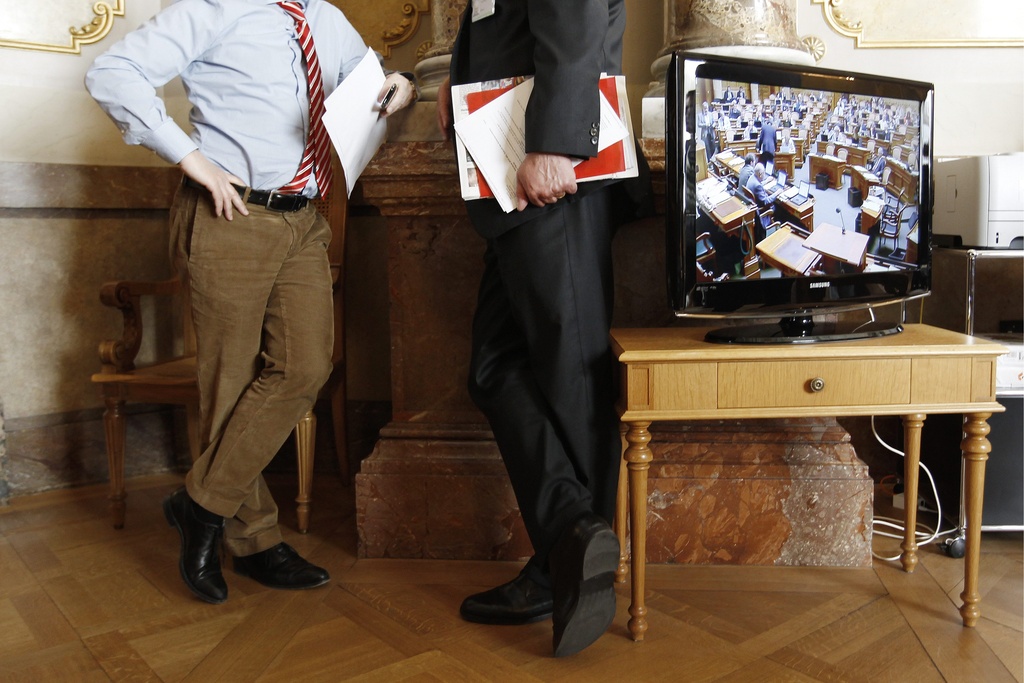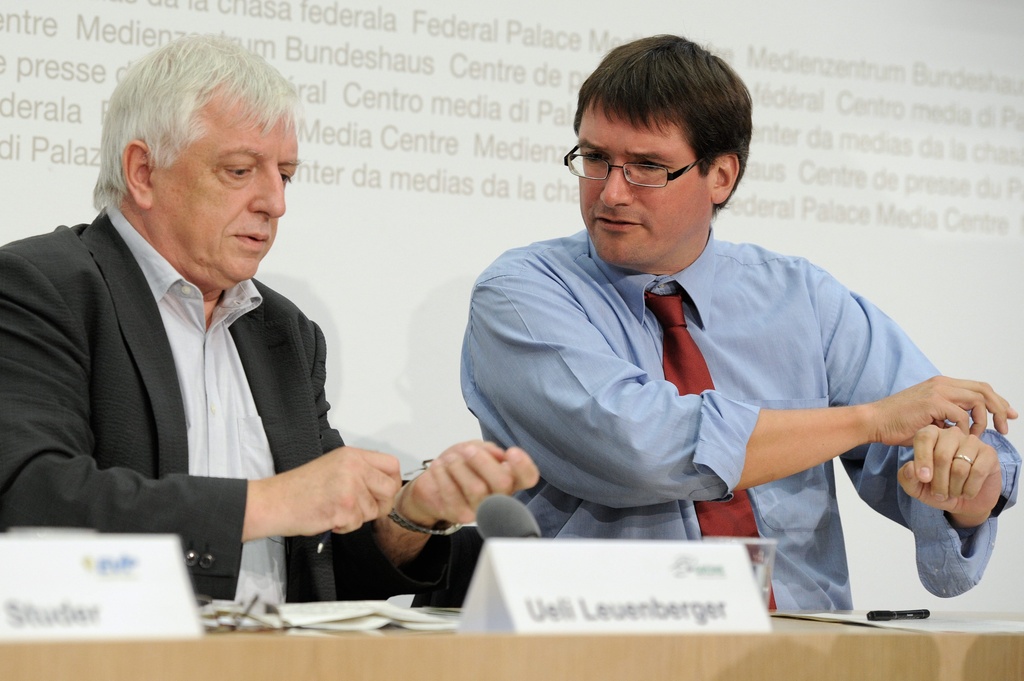Fragmented centre becomes political battleground

The battle for the centre ground is on as new groups challenge Switzerland’s two oldest political parties in October’s parliamentary election.
Under pressure to mobilise their grassroots, both the Radicals and the Christian Democrats have launched a series of initiatives covering tax breaks for families and the fight against rampant bureaucracy.
Elections in the cantons over the past four years have seen the two parties suffer a string of defeats. And all recent opinion polls have been rather pessimistic about their prospects in October. Experts predict gains for the Liberal Greens and the Conservative Democratic Party – both of them recent split-offs from established groups.
Experts say the established parties have suffered a serious loss of confidence among their traditional supporters.
Daniel Bochsler, assistant professor at Zurich University’s department for political sciences, says neither the Radicals nor the Christian Democrats have fully convinced voters.
“They have failed to send out clear signals in the case of the proposed nuclear opt-out and tougher banking rules,” he said.
Both parties are also paying the price for having been represented in government for more than a century.
“Discontented voters blame them for everything that might have gone wrong in the multi-party government,” said Bochsler.
Alternatives
The Liberal Greens and the Conservative Democrats for their part are seen as a fresh alternative, even if they are not really breaking new ground.
“They present fresh options without asking voters to radically change their political opinions,” said Bochsler.
The loss of the traditional centre-right parties is the gain of the newer groups from the same political spectrum.
“By default the small parties have fewer members eager to promote their own ideas and agendas. Their representatives therefore benefit from a higher credibility than others,” Bochsler added.
Profiles
The Radicals are the classic promoters of a lean state policy and are sometimes seen as a political extension of the business community, while the Christian Democrats, rooted in rural Catholic regions, are trying to champion family and environmental issues.
Both parties – the third and fourth biggest in parliament – claim they have been successfully defending the government’s policy line. However, pressure by the rightwing Swiss People’s Party has been growing over the past 25 years.
Still the Christian Democrats and the Radicals hope to increase their share of the vote by up to four per cent on October 23.
The Liberal Greens, which emerged more than four years ago amid a political and personal conflict in Zurich, are considered a less left-leaning offshoot of the Green Party. They appear to be enjoying a wave of support with their policies combining business interests and ecology.
The Conservative Democrats are standing for the first time in nationwide elections. They are trying to blend their conservative policy approach of a lean state with calls for a long-term nuclear opt-out. Criticising a growing polarisation in Swiss politics, they are calling for moderation in the political debate.

More
House of Representatives
Limits
Under the Swiss election system it is unlikely the two small groups will threaten the positions of the five top parties, leaving the Conservatives and the Liberal Greens to pursue a niche strategy.
They are not expected to make much more than five per cent of the vote. But they could eat into the electoral basis of the established parties, dashing their hopes of consolidating their standing after years of gradual decline.
The emergence of new parties is seen as a cyclical, partly also a local, political phenomenon. Whether the current trend towards fragmentation of the political centre is sustainable is an open question.
Claude Longchamp, political scientist and head of the gfs.Bern polling and research institute, is sceptical about the chances of the Conservative Democrats.
He acknowledges that they have been attracting supporters from amongst almost every other party in the past few weeks, not least because of their spectacular U-turn on nuclear energy.
“It is not clear where the party really stands and whether it is much more than a campaign instrument for its representative in the cabinet,” Longchamp said.
Finance Minister Eveline Widmer-Schlumpf was elected four years ago, following parliament’s refusal to confirm the de-facto leader of the Swiss People’s Party, Christoph Blocher.
At the time a member of the same party, Widmer-Schlumpf was expelled as a result and helped set up the more moderate rival group. Ever since the People’s Party has been demanding its second cabinet seat back.
In parliament
There are currently 12 political parties represented in the 246-member parliament. They are divided up into six separate factions.
The Swiss People’s Party is the largest group with 68 seats (including two seats from likeminded parties).
The centre-left Social Democrats and the Greens together hold 73 seats.
Computed figures show the centre-right parties holding a total of 104 seats in the 246-strong parliament, but there is only limited cooperation among these groups.
The elections to the two parliamentary chambers, the House of Representatives and the Senate, take place on October 23.
The centre-right comprises the Radicals (including the Liberals which were merged), the Christian Democrats, the Liberal Greens and the Conservative Democrats.
Two other small groups, the Protestant Party and the Christian Social Democrats, are within the same political band.
Computed figures show the centre-right parties holding a total of 104 seats in the 246-strong parliament, but there is only limited cooperation among these groups.
The Christian Democrats have formed an alliance with the Liberal Greens, the Protestant Party and partly with the Christian Social Democrats for the current parliamentary term.
But the Radicals as well as the Conservative Democrats have their own separate parliamentary groups.
The Radical Party is the Grand Old Party of modern-day Switzerland. From its glory days in the 19th century it has gradually been losing support. It has seen its share of the vote drop from 24% to 15.7% over the past 30 years.
The party is traditionally considered close to the business community.
In a bid to stop its power drain the Radicals merged with the more conservative Liberal Party in 2009, the historical founding fathers of Switzerland in 1848.
The Christian Democrats, formerly Catholic Conservative Party, were second behind the Radicals to win a seat in the cabinet in 1881.
Historically the party’s strongholds are in rural Catholic regions, notably in central and eastern Switzerland, but the party also has a more liberal wing.
Founded in 1848, the party enjoyed a 70-year period of relative stability that ended in the late 1980s. Its share of the vote was down to 14.5% in 2007.
The Liberal Greens are a centre-right split-off from the more left leaning Green Party. Their political credo includes environmental and social issues and a lean state.
The first local branches of the Liberal Greens were founded seven years ago with the national headquarters following in 2007.
Over the past four years its five parliamentarians have been cooperating with the Christian Democrats.
The Conservative Democratic Party was founded by moderate members of the rightwing Swiss People’s Party following a major dispute in 2007.
It is the first time the party is fielding candidates for the elections since most of its current parliamentarians were members of the People’s Party four years ago.
Despite its limited reach – only six seats in parliament – it has a seat in cabinet.
(With input from Armando Mombelli and Andreas Keiser)

In compliance with the JTI standards
More: SWI swissinfo.ch certified by the Journalism Trust Initiative














You can find an overview of ongoing debates with our journalists here . Please join us!
If you want to start a conversation about a topic raised in this article or want to report factual errors, email us at english@swissinfo.ch.